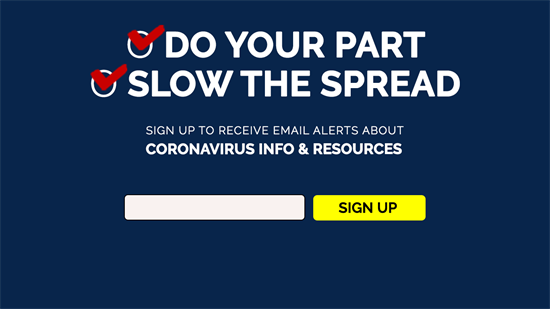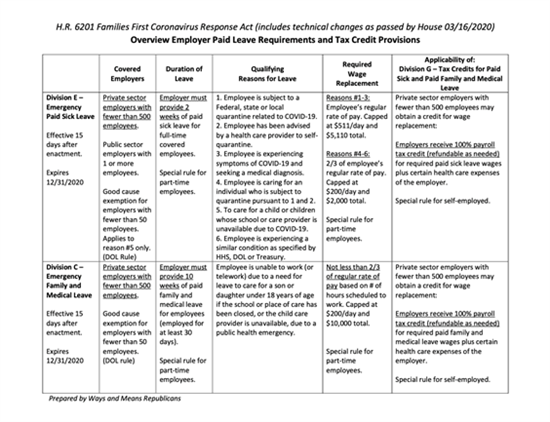Friend,
My colleagues over on the House Ways and Means Committee have put together a very informative "frequently asked questions" list regarding the federal government response to Coronavirus. I wanted to take a minute and share that with you, and help answer questions many may have. It covers a lot of information from seniors to small businesses - so I hope this is of some assistance to you.
As always, we are available to help any way that we can, so please don't hesitate to reach out.
Respectfully,
Jack Bergman
Small Businesses
I’m worried my small business will have to close due to financial issues. Will there be more assistance?
Secretary Mnuchin has made clear immediate assistance is on the way. Moreover, H.R. 6047— the first Coronavirus bill— allowed $1 billion in loan subsidies to be made available to help small businesses, small agricultural cooperatives, small aquaculture producers, and nonprofit organizations which have been impacted by financial losses as a result of the coronavirus outbreak. This funding could enable the Small Business Administration to provide an estimated $7 billion in loans to these entities. In addition, provides $20 million to administer these loans.
Testing and Supplies
What has Congress done?
H.R. 6047— the first Coronavirus bill— included more than $4 billion to make diagnostic tests more broadly available; to support treatments to ease the symptoms of those infected with the virus; and to invest in vaccine development and to procure vaccines when they are available.
Phase II Package
Small Businesses
My small business can’t afford to pay sick leave.
H.R. 6201— the second Coronavirus bill, — includes a refundable payroll tax credit to reimburse—dollar-for-dollar—local businesses for paid sick leave and family and medical leave wages paid to employees that are affected by COVID-19. Click here for an explanation of who is eligible and for what amounts.
The leave is fully funded by the tax credit, but my small business will be interrupted by cash flow issues.
H.R. 6201 provides significant relief to businesses that otherwise may not be able to afford the employee costs associated with coronavirus-related paid leave. Treasury has broad regulatory authority to advance funds to employers to protect businesses concerned about cash flow. In a March 14thpress release, Treasury stated that “employers will be able to use cash deposited with the IRS to pay sick leave wages. Additionally, for businesses that would not have sufficient taxes to draw from, Treasury will use its regulatory authority to make advances to small businesses to cover such costs.”
The legislation exempts businesses with more than 500 employees from mandated paid leave while imposing the requirement on small- and medium-sized job creators.
The benefits under H.R. 6201 are not an expense for the business, rather it operates as a benefit to both the worker and the employer. The legislation will ensure that every dollar of leave that an employer is required to pay is reimbursed—dollar-for-dollar—by the federal government. It will allow workers to care for themselves and loved ones impacted by coronavirus. Additionally, the credit will help businesses to stay up and running. After all, workers who knowingly show up sick jeopardize the health of coworkers and business operations. Nearly 90% of businesses with more than 500 employees offer paid sick leave to their full-time workers. To facilitate more universal coverage of paid sick leave, H.R. 6201 provides temporary federal coverage for paid sick and family leave to all employers with fewer than 500 employees.
Does the bill mandate an unaffordable extension of FMLA on my small business?
H.R. 6201 permits the Secretary of Labor to exempt businesses with fewer than 50 employees from the longer-term mandate where it creates significant hardship.
Mandatory Employer Paid Sick and Family and Medical Leave
How do employees find out if they can receive sick leave?
H.R. 6201— the second Coronavirus bill — requires employers to provide notice of eligibility to employees. The Department of Labor is required to create model notification within 7 days after enactment of the bill.
Unemployment Insurance
How does the H.R. 6201 support states that are experiencing a spike in claim for unemployment benefits due to COVID-19 layoffs and business closings?
The bill immediately provides $500 million in emergency administrative grants to increase state capacity to process unemployment applications and make payments. It also makes an additional $500 million available to states that experience a 10% percent increase in unemployment to provide 100% federally funded benefits to provide extra weeks of benefits.CRS has released a 3-page explainer document that reviews the paid leave and unemployment insurance provisions here.
Testing and Supplies
What has Congress done?
H.R. 6201— the second Coronavirus bill — requires free access to coronavirus testing, ensuring there are no cost barriers to these tests. It also included $1.2 billion to help cover the costs of testing, including $142 million to directly help our servicemembers and veterans.
The Vulnerable School-Aged and Elderly Population
Where can children and seniors get meals?
H.R. 6201— the second Coronavirus bill — provided half a billion dollars for WIC (the Special Supplemental Nutrition Program for Women, Infants, and Children) to help low-income pregnant women or mothers with young children who lose their jobs or are laid off due to the coronavirus emergency. It also included waivers to allow child and adult care centers to allow those eligible to take their food to go.
How can seniors get meals delivered?
H.R. 6201— the second Coronavirus bill— provided $250 million for the Senior Nutrition Program in the Administration for Community Living (ACL) to provide approximately 25 million additional home-delivered and pre-packaged meals to low-income seniors who depend on the Senior Nutrition programs in their communities. This funding will provide meals to low-income seniors:
- who are home-bound;
- who have disabilities;
- who have multiple chronic illnesses;
- as well as caregivers for seniors who are home-bound.
How did H.R. 6201 address the Emergency Food Assistance Program (TEFAP)?
H.R. 6201— the second Coronavirus bill — included $400 million to assist local food banks in meeting the demand for low-income Americans during the coronavirus emergency.
How did H.R. 6201 address Electronic Benefit Transfer (EBT) food assistance?
H.R. 6201— the second Coronavirus bill — allows the Department of Agriculture to approve state plans to provide emergency EBT food assistance to households with children who would otherwise receive free or reduce-priced meals if not for their schools being closed due to the coronavirus emergency.
How can I get child care?
H.R. 6201— the second Coronavirus bill — provides family leave for caretakers if the child’s school or place of care has been closed, or the child-care provider is unavailable, due to a coronavirus.
Health Coverage in the States
What assistance has Congress passed to help the states?
H.R. 6201— the second Coronavirus bill — provided a temporary increase in the federal share of Medicaid spending.
Phase III Package
The federal government has acted swiftly to help Americans impacted by the coronavirus. The first package, which has been signed into law, contained $8.3 billion to increase the availability of tests, support public and private efforts toward developing a vaccine, and assistance for small businesses. The second package, passed in the House and now being considered in the Senate, ensured free testing, emergency paid leave, and support and flexibility for small businesses.
This phase three package is further assistance for our economy. The Administration is seeking secured funds for industries that are taking a substantial hit due to this pandemic, such as airlines. They also want to provide cash assistance to all Americans, with the amount being dependent on income level and family size. And they want to create a loan program for small businesses who are offering paid leave to their workers at this time
Administration Action
Testing and Supplies
How is the Administration increasing access to personal protective equipment (PPE)?
The Administration is working with industry partners to increase capacity. Moreover, the USTR moved quickly to grant tariff exclusions to reduce the cost of a broad range of medical and health-related items, including hospital gowns and headwear, medical gloves, face masks, surgical drapes, biohazard bags, cleansing wipes, anti-microbial linens, and protective glasses.
Telehealth
Can seniors utilize telehealth to stay out of hospitals, but continue to receive necessary care?
Yes. Vulnerable seniors on Medicare need care, and providers must be able to focus on the most critical patients, especially during this national emergency. The Trump Administration has quickly acted on Congress’s work in the first coronavirus emergency supplemental to expand access to telehealth. Beginning on March 6, 2020, Medicare will temporarily broaden its policy to pay clinicians to provide telehealth services for seniors across the country. A robust FAQ via CMS— which includes what services are eligible and enforcement details— can be found here.
Social Security Administration
Since all SSA field offices are closed to the public, how do I find the phone number of the local field office?
You can find the contact number via the SSA website – https://secure.ssa.gov/ICON/main.jsp
Or you can always call SSA’s 800 number at 1-800-772-1213 (TTY 1-800-325-0778)
I need a benefit verification or a new/replacement Social Security card, but my local field office isn’t processing those right now. What do I do?
While SSA field offices are prioritizing dire need and benefits related actions at this time, the SSA’s online portal, mySocialSecurity, can be used to obtain a benefit verification and in most states, a replacement Social Security card. Access the portal here: www.socialsecurity.gov/myaccount
Other Commonly Asked Questions
Access to Unemployment Insurance
What flexibility is there for states to offer unemployment insurance now to individuals that have lost their job or are unable to work due to COVID-19 crisis?
DOL has issued guidance that can be found here, which explains flexibility states have to provide unemployment benefits when:
- An employer temporarily ceases operations due to COVID-19, preventing employees from coming to work;
- An individual is quarantined with the expectation of returning to work after the quarantine is over; and
- An individual leaves employment due to a risk of exposure or infection or to care for a family member.
To find out details on your state’s unemployment insurance program, visit DOL’s website here.
Also, you can find a list of state-specific FAQ’s about unemployment insurance and COVID-19 here.
Testing and Supplies
Where can my local health officials get more tests?
Tests can be ordered from IDT, ThermoFisher, or Roche. All state public health labs are up and running, and LabCorp and Quest are also running tests. CDC continues to update its guidance, which can be accessed here.
The Vulnerable School-Aged and Elderly Population
Can individuals use their SNAP (food stamps) for hot meals, drives thru, restaurants, etc.?
- Most individuals cannot use their SNAP EBT cards to buy hot or prepared foods. The FNS website offers a list of eligible items here. Some States operate a Restaurant Meals Program, a special State-run program allowing SNAP consumers to purchase restaurant foods at concession prices. Currently, only Arizona and California participate in this program. Additional information can be found here and here.






